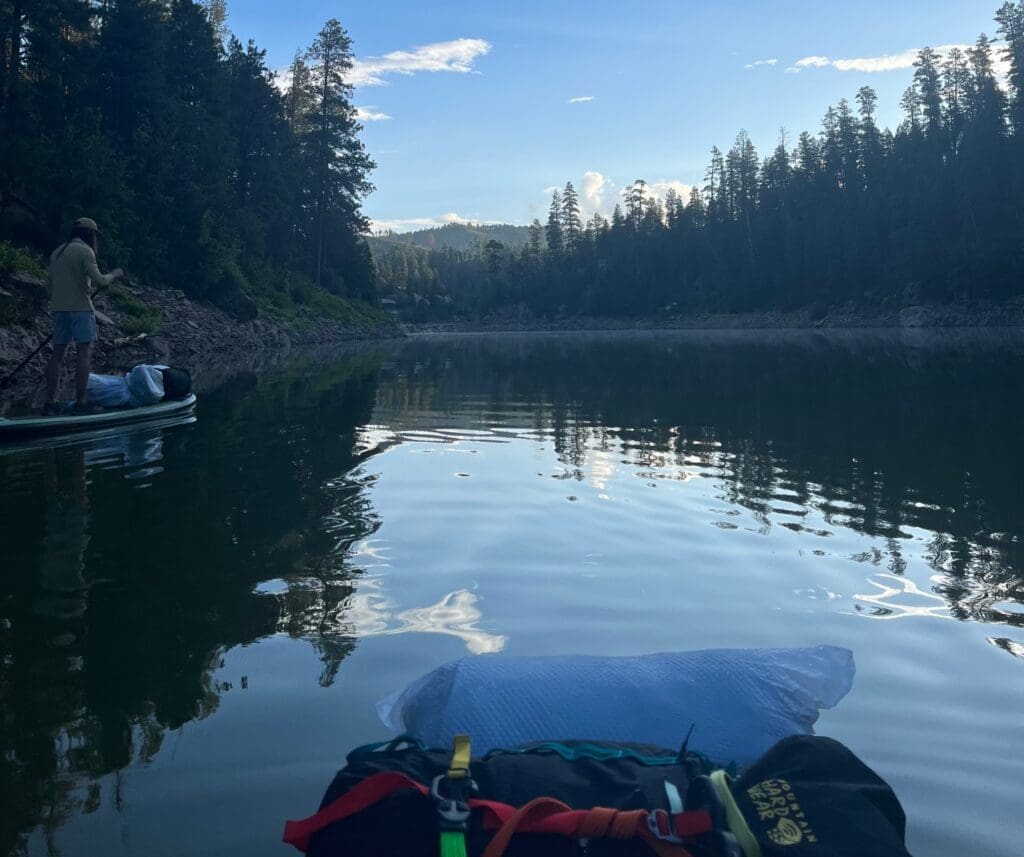Water in the Arizona Desert
“It’s so special because of how remote it is,” says Aaron Horton, an employee at Peace Outfitters. “And it’s so large that you can paddle for most of the day, exploring different draws and off-chutes of the lake.” He makes the two hour drive to Blue Ridge Reservoir, located near Happy Jack, about once or twice a month in the summers to fish for rainbow trout, camp, and swim. Like most water sources in Northern Arizona, Blue Ridge (or C.C. Cragin) Reservoir is a narrow, winding body of water that appears more like a canyon than it does a lake. Most of the shoreline is steep and rocky, making it an ideal spot to kayak, canoe, or paddle board. “You just have to watch out for ‘Logmageddon,’ as my friends and I call it,” Aaron warns. “You’ll have to paddle around hundreds of floating logs, especially in the early mornings.” There are also campsites and trails nearby, meaning that one can spend several days among the ponderosa pines. The best part however, Aaron says, is simply being on the water.
In a state like Arizona, one might not expect there to be an abundance of water-based recreation. But water in the desert is a special thing: deep, narrow canyons formed by water cutting into layers of basalt, limestone, and sandstone; lush riverbanks nestled underneath the shade of cottonwood trees; and cerulean lakes that reflect the deep greens of pines and spruce. These bodies of water, seemingly impossible at times, offer ample opportunities for water-based recreation. Like many in Flagstaff, we’re excited for warmer weather and longer days in part because it means we can enjoy more time spent on, in, and around these waters across Northern Arizona.

Best Watering Holes and Waterways Near Flagstaff
Within a half-day’s to a full-day’s drive of Flagstaff, there are numerous areas to swim, kayak, fish, camp and more. Below are some of our staff’s favorite spots.
- Oak Creek: Flowing from its headwaters south of Flagstaff to its confluence with the Verde River near Cottonwood, Oak Creek is one of the Flagstaff-area’s most beloved waterways. It cuts deep through layers of basalt and sandstone to form the famous Oak Creek Canyon, where recreationists can enjoy a myriad of activities from hiking and backpacking to fishing for rainbow trout.
- From Flagstaff: 30 minutes to 1 hour, depending on where you go.
- Activities: Hiking, fishing, swimming, cliff jumping, camping
- Don’t Miss: Check out the West Fork of Oak Creek for a beautiful hike or backpacking trip and Grasshopper Point for an afternoon of cliff jumping and cooling off.
- East Clear Creek: Located about an hour and a half from Flagstaff near the town of Winslow, East Clear Creek is a tributary of the Little Colorado River. It is most commonly accessed from McHood Park, where recreationists can begin a day of paddling via paddleboard, kayak, or even packraft. Large sandstone walls line the water, creating cliffs with great opportunities for jumping in and cooling off.
- From Flagstaff: 1.5 hours
- Activities: Paddling, swimming, fishing, deep water soloing
- Don’t Miss: If you are a climber, East Clear Creek provides awesome opportunities for deep water soloing. Bring an old pair of shoes and a chalk bag and enjoy a day of bouldering above the water.
- West Clear Creek: Located between Happy Jack and Camp Verde, West Clear Creek is an east-west running waterway that forms the magnificent West Clear Creek Canyon. About 45-miles long and with numerous access points, it is paradise for backpackers, canyoneers, and fishers. Deep pools and massive sandstone walls characterize this area, which can be enjoyed as a day trip or as a multi-day backpack. Note that there is no way to access West Clear Creek by car – it is at least a few mile hike to the water depending on where one starts.
- From Flagstaff: 1.5 to 2 hours, depending on where you go.
- Activities: hiking/backpacking, canyoneering, swimming, fishing
- Don’t Miss: Sundance Canyon is a deep and major side canyon of West Clear Creek Canyon, and can be accessed from the bottom via the Maxwell Trail and a short hike downstream. Wading required!
- Verde River: Approximately 170 miles in length, the Verde River is a major tributary of the larger Salt River to the south. It is one of the largest perennial streams in Arizona, flowing freely for 125 miles through private, state, tribal, and U.S. Forest Service land. In Northern Arizona, it is commonly accessed in or near the town of Cottonwood, where recreationists can enjoy the warm air and cool water.
- From Flagstaff: 1 to 2.5 hours, depending on where you go.
- Activities: Paddling, floating, swimming, fishing, camping
- Don’t Miss: For a beautiful spot to swim and a piece of interesting history, visit the Sheep Bridge over the Verde River near the town of Cave Creek. Originally constructed in 1944 by the Flagstaff Sheep Company, the bridge served to minimize the loss of sheep when crossing the river.
- Blue Ridge Reservoir: Tucked away in the pines near the Mogollon Rim, Blue Ridge (or C.C. Cragin Reservoir) is a beautiful canyon-lake and an important water source for the town of Payson. The lake is stocked with rainbow trout by the Arizona Game and Fish Department, making it a popular destination for fishing. Paddling is popular too, as the steep, rocky shoreline means swimming is only possible once already on the water.
- From Flagstaff: 2.5 hours
- Activities: Paddling, swimming, fishing, camping, hiking, mountain biking
- Don’t Miss: The topography of Blue Ridge Reservoir lends itself to exploration on both watercraft and foot. If you’re already on the water, be sure to check out side canyons and draws that you can continue to explore by hiking.
- Lake Powell: As one of the largest reservoirs in the U.S., Lake Powell sees more than 2 million visitors each year. It was created in 1966 when Glen Canyon was flooded by the construction of the Glen Canyon Dam. In 1972, the Department of Interior established the Glen Canyon National Recreation Area, solidifying Lake Powell as a major destination for recreation and tourism.
- From Flagstaff: 2 hours to Page, the main access point for most visitors; up to 5+ hours to access more remote spots on the north side of the lake. Many areas are only accessible by watercraft.
- Activities: Paddling, boating, swimming, cliff jumping, fishing, camping
- Don’t Miss: Paddle up Lower Antelope Canyon, a 2 mile paddle from Antelope Point Marina. From there you can hike 3 miles further up the slot canyon. Note that the upper portions of Antelope Canyon are protected by the Navajo Nation and can only be visited with a guide.
While many of these areas can be enjoyed by foot, they are best experienced on the water. Paddling is a great way to do just that; whether you’re on a kayak or canoe, stand-up paddleboard (SUP), or packraft, a day or more spent on the water is precious.
Enticed by the waters of Northern Arizona by don’t have any of these watercraft? No worries – Peace Outfitters has you set with SUP rentals that include a paddle, PFD (life jacket), and pump. Give us a call at 928-779-4521 or swing by the store to inquire.
The State of Water Resources in Arizona
In 1922, the governments of seven western states came to an important agreement. The Colorado River Compact was formed, allocating the river’s water to those states through which it flows. The Law of the River, as it came to be known, eased years of tension and disputes between the states and drastically altered the trajectory of water resources in the western U.S.
The agreement, however, was deeply flawed. Ignoring the best available science, the Colorado River Compact overallocated the river’s water. It apportioned 7.5 million acre-feet of water between the upper and lower basins of the river based on an estimated annual flow of 16 million acre-feet per year; the river’s actual annual flow, however, is only around 13 million acre-feet annually. In recent decades, major dams and diversions to cities like Los Angeles and San Diego and periods of climate change-induced drought have exacerbated this already-dire situation; states in the Lower Colorado River Basin, like Arizona, are especially impacted. Now, more than a century since the agreement was signed, the Colorado River rarely reaches its delta in the Gulf of California.
Doomed from the beginning, the Colorado River Compact is an unfortunate example of the difficulties of managing water in the American southwest. Demand for water in the region is high: rapid urbanization and sprawl in cities such as Phoenix, Las Vegas, and Los Angeles necessitates water for municipal purposes while a vast majority of the U.S.’ winter vegetables are produced in Arizona and Southern California. And during periods of extreme drought brought on by a rapidly changing climate, water resources in Arizona and its neighboring states are more important than ever.
Water in the desert is special, not only because of its diversity and beauty but also for its fragility. As recreationists and part of the Northern Arizona community at large, we are stewards of the landscapes in which we live, work, and play. As such, it is crucial to understand, cherish, and ultimately work to protect the state’s waterways.
- Leave No Trace: When recreating on or near the water, always practice Leave No Trace principles by packing out waste, leaving behind what you find in or near the water (unless it is trash), and respecting riparian and lacustrine wildlife.
- Education: Understanding the state of and threats to our water resources is the first step in better protecting them. Many resources are available online from federal agencies like the U.S. Geologic Survey and the U.S. Forest Service. Northern Arizona University is a great hub for water resources education as well.
- Get Involved: There are many ways to get involved in the water conservation community in Northern Arizona. Organizations such as the Oak Creek Watershed Council, the Grand Canyon Conservancy, the Grand Canyon Trust, the American Conservation Experience (ACE), and the Glen Canyon Conservancy are just a few examples of conservation nonprofits working to protect water and other natural resources across Northern Arizona.
